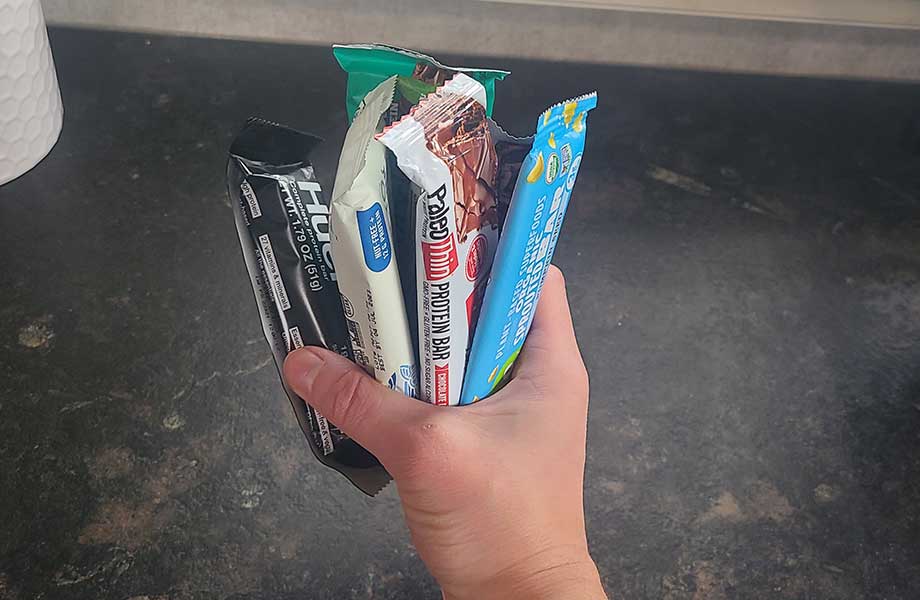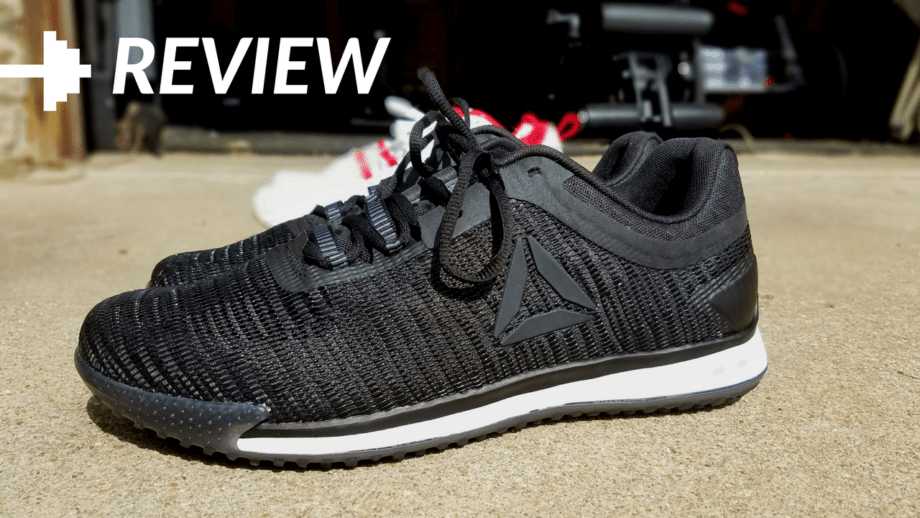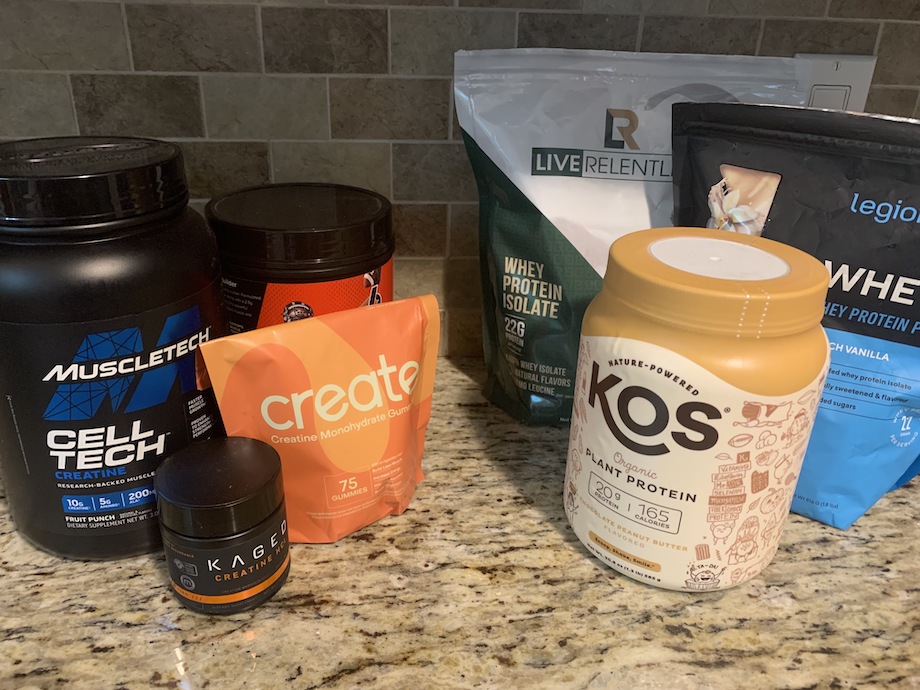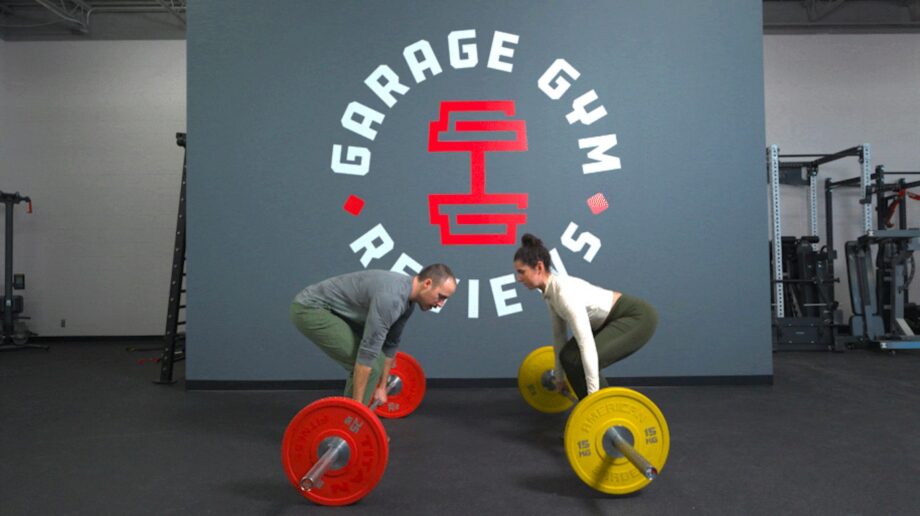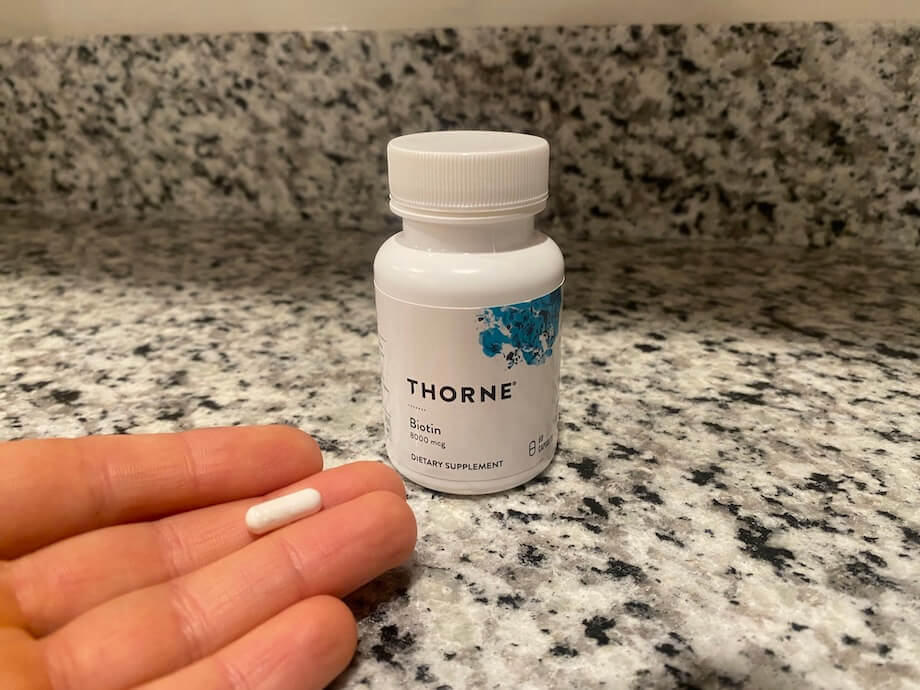Whether you’re an athlete, building muscle, on a weight loss journey, or are simply looking for a filling snack to help with meeting your protein goals, protein bars can be a helpful addition to your health and fitness routine.
However, finding the best protein bars on your own can be a challenge. This is especially true considering how many different brands are available, and it can be even harder if you have specific dietary needs or preferences.
As a dietitian, I know that nutrition isn’t one-size-fits-all. That’s why I’ve teamed up with the expert testers at GGR to bring you our top picks for the best high protein bars. They’ve personally tested dozens of bars—some great and some not so great—to help make your choice a lot easier. They rated each bar on a scale of 1 to 5 for a variety of categories, including taste, formulation, texture, and price, to name a few.
Medical disclaimer: This article is intended for educational and informational purposes only. It is not intended as a substitute for medical advice. For health advice, contact a licensed healthcare provider.
Best High Protein Bar
- Best Overall High-Protein Bar: Legion Protein Bar
- Best Paleo High-Protein Bar: Julian Bakery Protein
- Bar Best Plant-Based High-Protein Bar: Huel Complete Protein Bar
- Best Budget High-Protein Bar: PowerBar Protein Plus
- Best-Tasting High-Protein Bar: BSN Protein Crisp Bar
- Best Low-Carb High-Protein Bar: Quest Protein Bar
- Best Low-Calorie High Protein Bar: Pure Protein Bar
Best Overall High-Protein Bar: Legion Protein Bar
Good for: Those who want a great-tasting, high-fiber protein bar that’s third-party tested
Best Overall
Legion Athletics Protein Bar
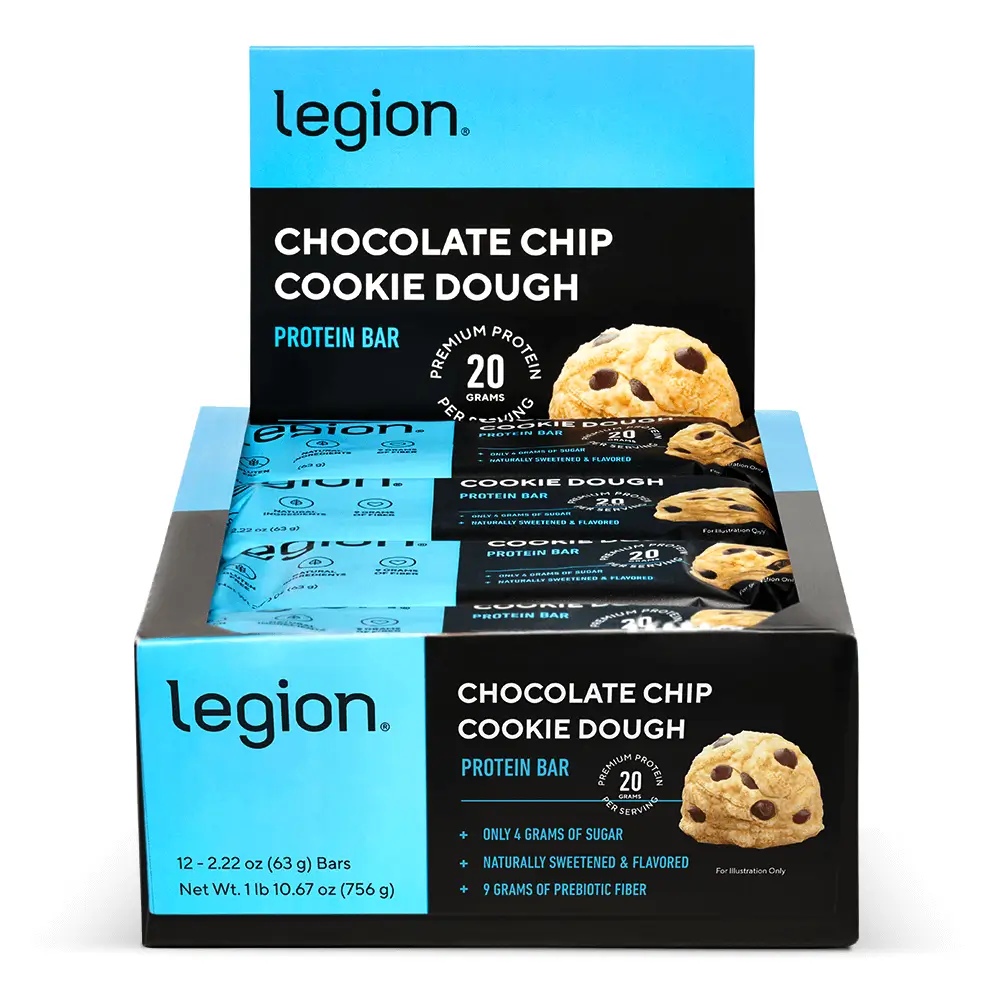
Product Highlights
- Blend of whey and milk protein
- Plant-based carbs, fats, and prebiotic fiber
- Third-party tested
- No proprietary blends
- Money-back guarantee
Pros & Cons
Pros
- All natural
- Non-GMO
- Third-party tested
- Money-back guarantee
- NSF-certified
- FDA-inspected, cGMP facilities
Cons
- Too hard for some
- Contains stevia and erythritol (a sugar alcohol)
- 4 g of added sugar
Bottom Line
If you are looking for an all-natural protein bar and do not mind a little added sugar, the Legion Athletics Protein Bars are available in two popular flavors.
With 20 grams of protein, great flavors, an impressive nutrition profile, and excellent customer service, Legion Protein Bars were an easy choice as the best overall high-protein bar.
Kate Meier, NASM-CPT, USAW-L1, CF-L1, tested two different flavors. Said Kate, “The chocolate peanut butter flavor tasted really chocolatey, which I loved. The chocolate chip cookie dough flavor was nice as well, but didn’t contain enough chocolate for me. I’d rate the chocolate peanut butter a 4 out of 5 and the cookie dough bar a 3.”
The texture of this bar isn’t great, but it isn’t terrible either. “It looks a lot like a Larabar, but it’s actually a bit drier. I noticed that it also sticks to your teeth and takes a while to chew since it’s such a dense bar,” added Kate.
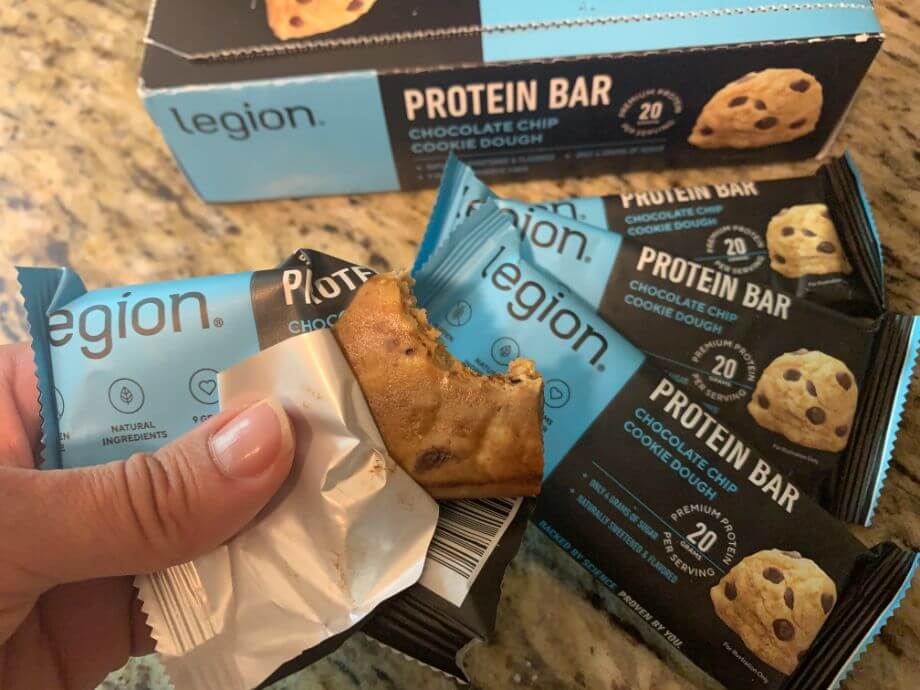
It’s third-party tested by Labdoor for purity, which is impressive considering how rare third-party testing is for protein bars. I also like that it contains 9 grams of gut-friendly fiber and is low in added sugars.
Keep in mind that since it’s relatively high in fat, it isn’t a very lean bar. This isn’t necessarily a problem, though, it just depends on your training goals. It’s one of the best protein bars for bodybuilding, but may not be the best choice for weight loss.
Legion has excellent customer service policies, with Kate rating them a 5 out of 5. She was particularly impressed with their refund policy, noting that “Legion will refund you for any product you don’t like without requiring you to send the product back.”
| Price per serving | $3.00 with a subscription$3.33 as a one-time purchase |
| Protein per serving | 20 g |
| Calories per serving | 240 |
| Protein source | Whey Protein Concentrate, Milk Protein Isolate, Whey Protein Isolate |
Best Paleo High-Protein Bar: Julian Bakery Protein
Good for: Those looking for an egg white-based protein bar with no sugar alcohols
Best Paleo
Julian Bakery Paleo Thin Protein Bar
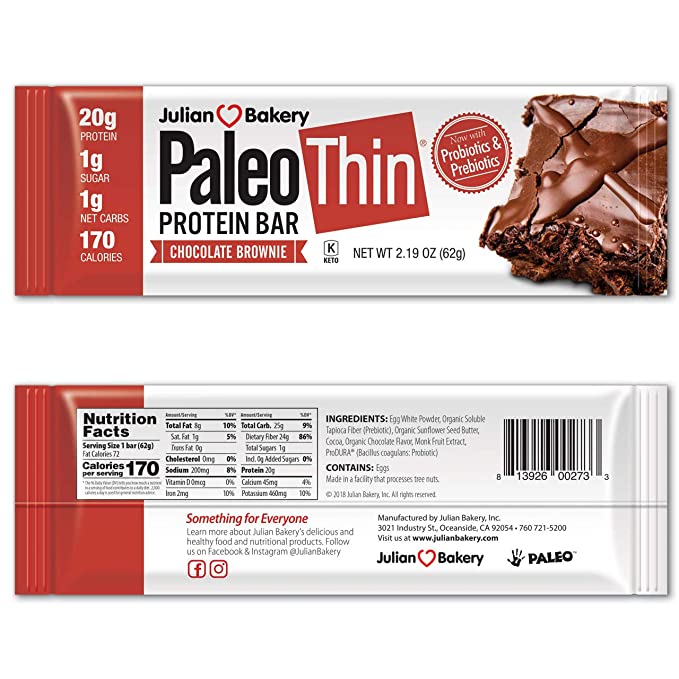
Product Highlights
- Non-GMO and 100% gluten-free protein bar available in vanilla cake, chocolate brownie, and sunflower butter flavors
- The protein comes from egg whites
- Appropriate for both a keto and paleo diet
- Each bar contains 170 cal, 8 g of fat, 25 g of total carbohydrates, 24 g of fiber, and 20 g of protein (may vary slightly by flavor)
- Added ProDura probiotic to support gut health
Pros & Cons
Pros
- According to reviews, it effectively curbs hunger
- Well-liked taste
- Added probiotics
- High in fiber
- Keto- and paleo-friendly
Cons
- Comparably expensive
Bottom Line
If you are looking for an all-natural, high-quality protein bar that is both keto- and paleo-friendly, the Julian Bakery Paleo Thin Protein Bars are a solid choice.
The Paleo-Thin bars from Julian Bakery are made with egg white protein rather than your typical whey or pea protein, making them more appropriate for those on a Paleo diet.
GGR Editor Frieda Johnson, NASM-CNC, ISSA-SET, tried the chocolate brownie flavor. She liked the ingredients, but didn’t enjoy the taste as much. “I’m not a big fan of how these taste—they’re a bit bitter. I love that it doesn’t have sugar alcohols, fillers, or artificial sweeteners, but the taste and texture just didn’t do it for me,” said Frieda, rating the taste a 2 out of 5.
She rated the texture a little better at 3 out of 5 stars. “It reminds me a lot of the gooey texture of a tootsie roll. You’ll probably love it if you like this candy, but I didn’t enjoy it,” she added. The soft texture may be due in part to the use of sunflower seed butter, so the texture may not be a problem if you really value the heart-healthy fats.
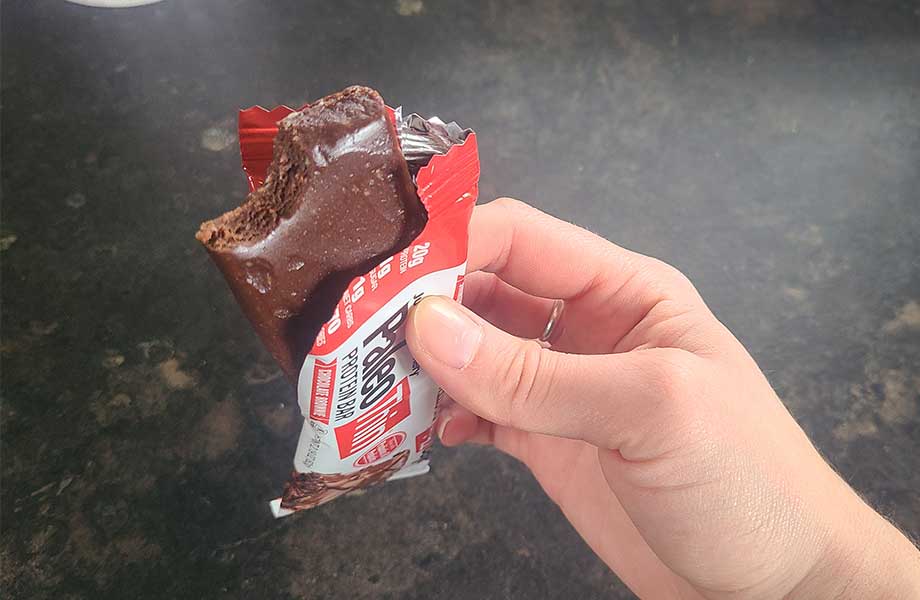
The macros of this bar are impressive, with 20 grams of protein and only 170 calories. It’s also GMO-free and gluten-free with no sugar alcohols. Sugar alcohols are safe to consume and help keep the sugar content low, but they aren’t well-tolerated by everyone.
This bar also contains the probiotic bacterial strain Bacillus coagulans, which the brand claims can help promote gut health. Unfortunately, they don’t list the number of Colony-Forming Units (CFUs) present in each bar, so it’s difficult to judge how much of an impact it could have on the gut microbiome.
Unfortunately, these bars were no longer available on Amazon at the time this article was written, so we were unable to find the current pricing.
RELATED: Protein Bar vs Shake
| Price per serving | Current price unavailable |
| Protein per serving | 20 g |
| Calories per serving | 170 |
| Protein source | Egg White Powder |
Best Plant-Based High-Protein Bar: Huel Complete Protein Bar
Good for: Those who prefer getting their protein from plants and aren’t picky when it comes to flavor
Best Plant-Based
Huel Complete Protein Bar
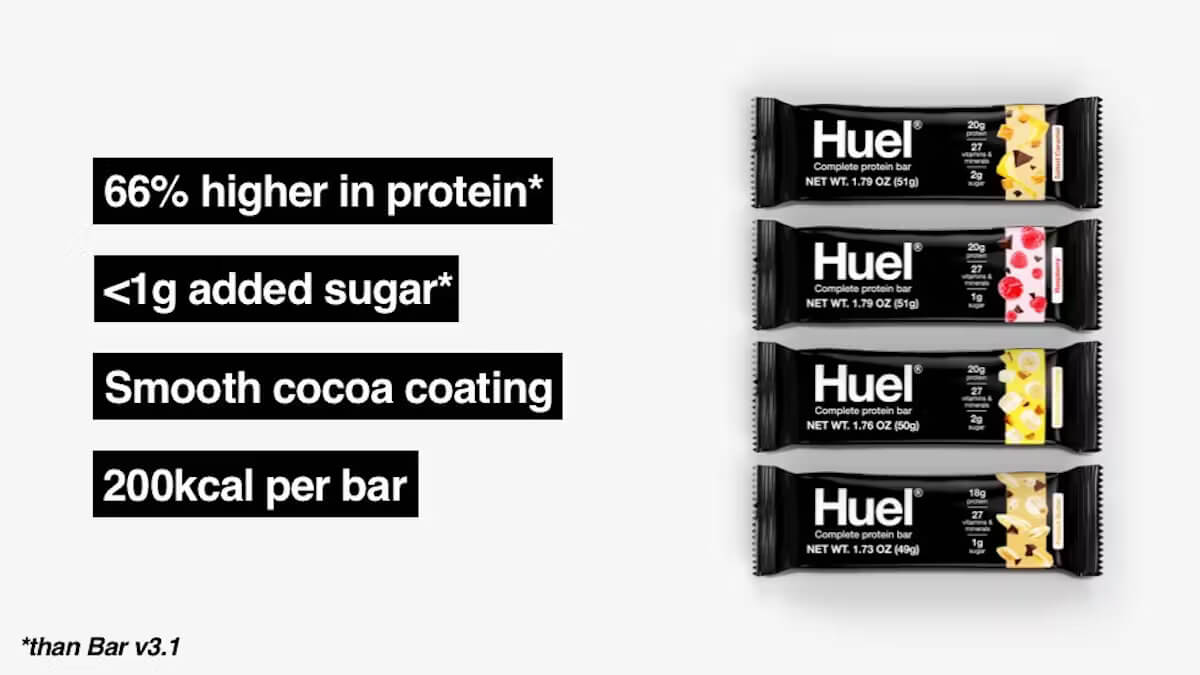
Product Highlights
- Gluten-free, dairy-free, and vegan
- Claimed to be a nutritionally complete snack
- Each bar contains 27 vitamins and minerals
- 200 calories per bar
Pros & Cons
Pros
- Micronutrient blend
- Solid macro split
- All-natural ingredients
- Gluten-free, dairy-free, and vegan
Cons
- Must order 2 boxes
- Price is high
- Review on taste are mixed
Bottom Line
If you are looking for an all-natural, vegan protein bar that is high in protein but lower in carbs and sugars, the Huel Complete Protein Bars may be a good choice for you.
Huel Complete Protein Bars are a solid option for vegans and flexitarians. They’re non-GMO, dairy-free, and 100% plant-based, made from a blend of wheat gluten (the main protein in wheat), rice protein, and pea protein.
Interestingly, they’re fortified with a blend of 27 different vitamins and minerals, which, in my opinion, is unnecessary for a protein bar since most people are already getting enough from their regular meals. That said, vegans might benefit from the small boost of vitamins B12 and D.
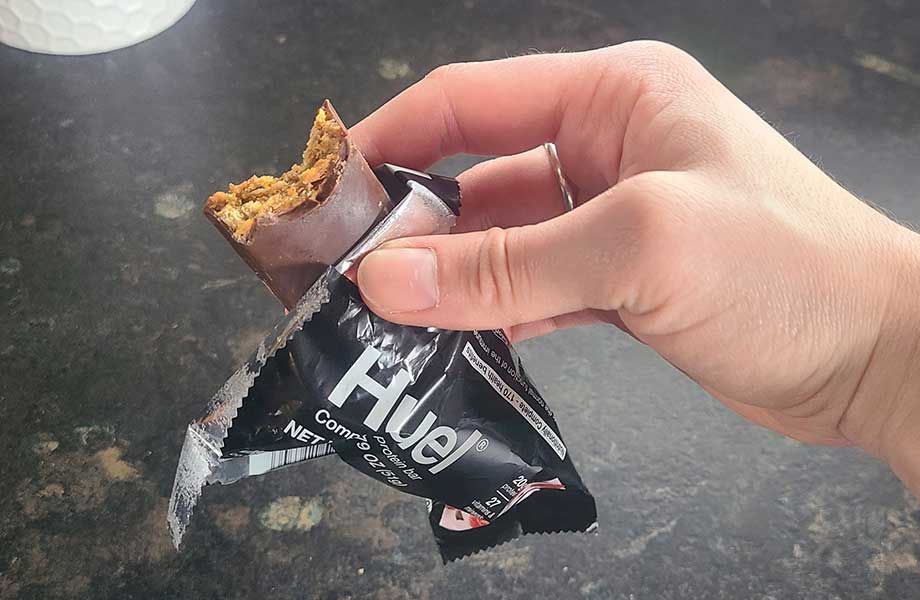
GGR Editor and Certified Nutrition Coach Frieda Johnson chose to try the Dark Chocolate Raspberry and Salted Caramel flavors. “I’d give these bars a 1 out of 5 for taste. The “cocoa coating” was really disappointing—it tasted like wax and the sugar alcohol flavor was overpowering. I also don’t think I would have been able to identify what flavors these bars were supposed to be if they weren’t labeled,” she said.
The texture was better, earning a 3 out of 5 rating from Frieda. “It was fine but nothing special,” she said, noting that it was comparable to most other protein bars she’s tried in the past.
These bars are a bit pricey for only 13 grams of protein, which isn’t ideal for those trying to build muscle. Combined with the 6 grams of dietary fiber, however, they’re pretty satiating. I’d say these bars are best used in place of other snacks that don’t have much protein.
For other plant-based options, read our round-up of the best vegan protein bars.
RELATED: Plant Protein vs Animal Protein
| Price per serving | $2.71 |
| Protein per serving | 13-14 g (Depending on flavor) |
| Calories per serving | 180-190 (Depending on flavor) |
| Protein source | Wheat gluten, rice protein, pea protein |
Best Budget High-Protein Bar: PowerBar Protein Plus
Good for: Protein lovers on a budget who don’t mind a bar higher in added sugars
Best Budget
PowerBar Protein Plus Bars
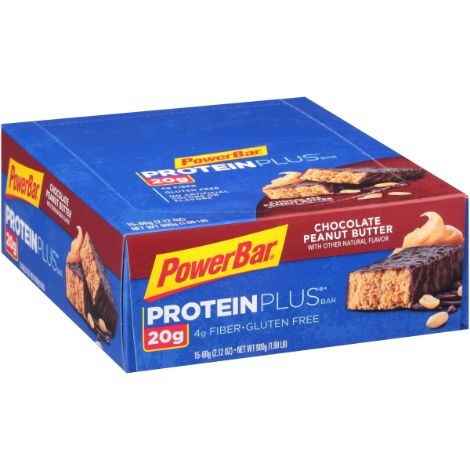
Product Highlights
- 20 g of protein
- Gluten-free
- No artificial flavors or colors
- Available in 4 flavors
Pros & Cons
Pros
- No artificial flavors or colors
- 20 g of protein
- Gluten-free
- Inexpensive
Cons
- Higher sugar content
- Some reviews don’t like the texture of the bar
Bottom Line
With 20 grams of protein in one bar, PowerBar Protein Plus Bars are a good high-protein snack. Additionally, the protein bars have no artificial flavors or colors, and are also gluten-free and soy-free. Protein Plus Bars come in four flavors: Chocolate Peanut Butter, Peanut Butter Cookie, Cookies and Cream, and Vanilla.
First introduced in 1986, PowerBar Protein Plus bars are familiar to many protein bar aficionados. They’re what you’d expect from a standard protein bar—high in protein, available in dessert-inspired flavors, and a bit dense. They may not be the most exciting option, but at only $1.38 a bar, they’re a great fit for tighter budgets.
GGR Senior Editor Erin Chancer, CNC, CPT, gave us her thoughts on the Cookies & Cream flavor. “I didn’t love it, but I didn’t hate it either. The flavor was OK, but there’s a strong aftertaste,” she said, rating it a 3 out of 5.
She gave the texture 3.5 out of 5 stars, noting that “it’s actually pretty good! A bit chalky, but that’s standard for protein bars. It wasn’t enough to be off-putting.”
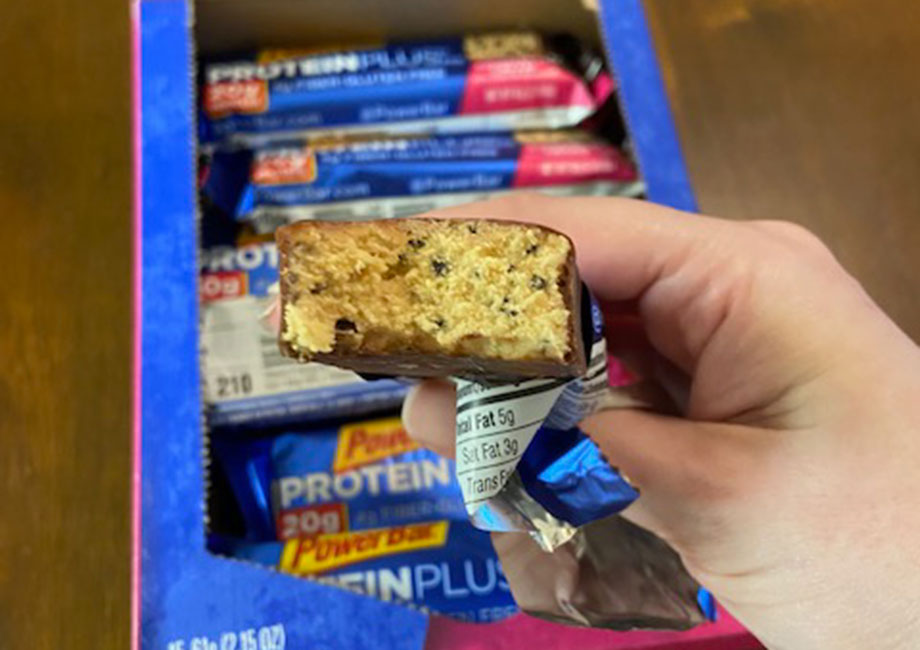
Erin did experience a little protein gas, but otherwise tolerated the bar with no issues. She rated it a 4.5 out of 5 for side effects.
She liked the direct customer service phone line and contact form listed on the PowerBar website, options that make it easy to contact the company if needed. We rated the customer service a 4.5 out of 5 thanks to their accessibility.
This isn’t the most nutrient-dense bar, but it does offer a hefty 20 grams of protein. It’s higher in added sugars than I’d say is ideal for a protein bar, but it could be a good high-protein replacement for desserts.
| Price per serving | $1.38 from Walmart; $2.60 from Amazon |
| Protein per serving | 20 g |
| Calories per serving | 210 |
| Protein source | Trisource™ Protein Blend (Soy Protein Isolate, Calcium Caseinate, Whey Protein Isolate) |
Best-Tasting High-Protein Bar: BSN Protein Crisp Bar
Good for: Crunchy puffed rice fans who don’t mind artificial sweeteners or sugar alcohols
Best-Tasting
BSN Protein Crisp Bars

Product Highlights
- 20 g of protein from milk, whey and soy
- Made with a crunchy texture
- Gluten-free
- Only 2-5 g of sugars
- Six flavors
Pros & Cons
Pros
- 20 g of protein
- Gluten-free
- 6 flavors
- Low sugar
Cons
- Pricier protein bar
- Contains soy
- Contains artificial flavors
Bottom Line
Made with a crunchy texture, BSN Protein Crisp Bars provide 20 grams of protein from a blend of whey, milk, and soy protein. The protein bars contain low added sugars, and come in six different flavors as well.
Puffed rice fans rejoice! BSN Protein Crisp bars have the pleasantly crispy texture you crave while offering a solid 20-gram dose of protein to boot. They’re gluten-free, low in added sugars, contain a small boost of dietary fiber, and come in delicious candy bar-like flavors.
GGR Senior Staff Writer Lauren Strong, CPT, rated the Salted Toffee Pretzel a solid 4 out of 5. “This wasn’t the best protein bar I’ve ever had, but it was pretty good! It’s sweet enough to satisfy a sweet tooth, but not overpoweringly so. The amount of chocolate drizzle is just right—it adds a bit of flavor without the fake chocolate flavor being too strong,” she said.
RELATED: Best Tasting Protein Bar
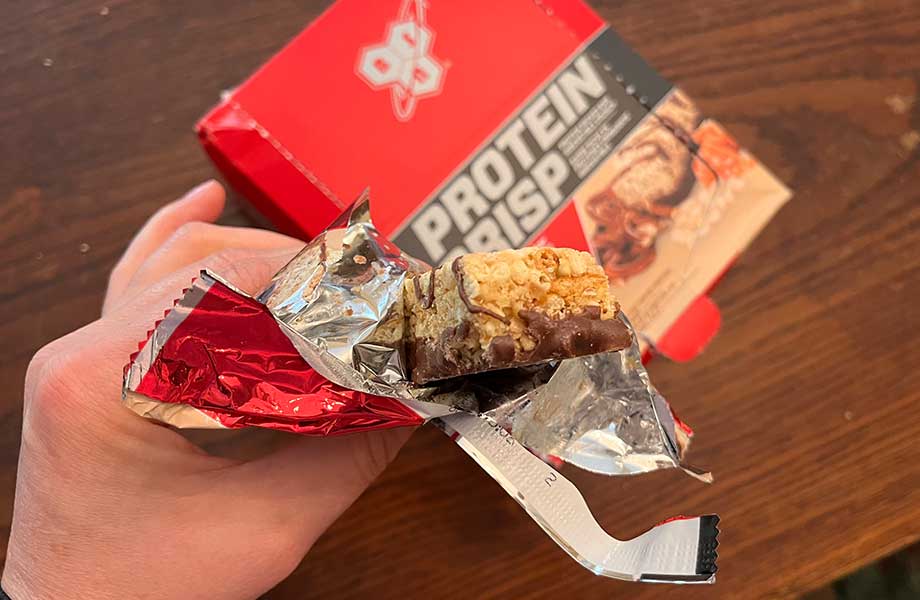
She was a huge fan of the texture, giving it 5 out of 5 stars. “This bar is chewy from the puffed rice, so there’s actually some substance to this bar. It feels more like real food than many of the softer or leather-like bars out there. The chocolate layer on the bottom is a nice touch, as well,” she noted.
It also scored well in terms of side effects with 4.5 out of 5 stars. Lauren experienced some dry mouth but noted that that’s pretty normal for her with protein bars.
I’m not the biggest fan of the ingredient list, which includes artificial flavors and sweeteners. This bar is also fairly high in saturated fat with 20% of the Daily Value. However, it’s a good option for people who don’t like the typical protein bar texture and want something with a little more bite to it.
RELATED: Different Types of Protein
| Price per serving | $2.26 |
| Protein per serving | 20 g |
| Calories per serving | 190 |
| Protein source | Milk Protein Blend (Whey Protein Isolate, Whey Protein Concentrate, Milk Protein Concentrate), Soy Protein Isolate |
Best Low-Carb, High-Protein Bar: Quest Protein Bar
Good for: Those on low-carb diets who can tolerate erythritol and don’t mind a lot of chewing
Best Low-Carb
Quest Nutrition Protein Bars
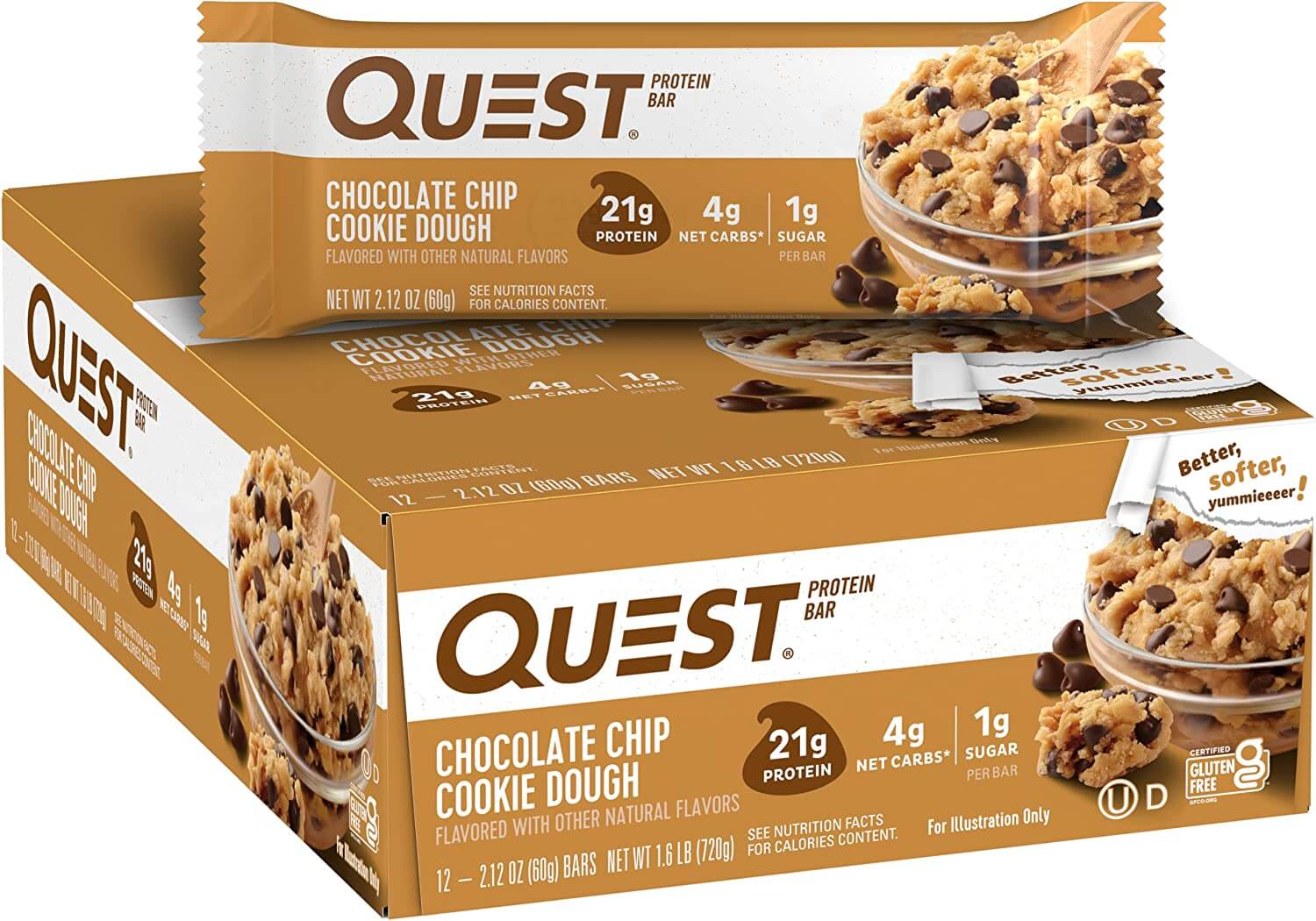
Product Highlights
- Gluten-free
- Low-sugar
- 16 flavor options
- 17-21 grams of protein depending on the flavor
- Low net carbs
Pros & Cons
Pros
- Great product to keep your macronutrients on target
- Simple, grab-and-go snack
- Gluten-free helps with dietary restrictions
- Low in sugar
- Very filling
Cons
- Chewy texture isn’t for everyone
- Uses sugar alcohols, which can upset digestion
- The company recently changed the formula a bit and several customers didn’t like the change
- Can get too soft if gets too hot (like in a car or gym bag)
Bottom Line
Quest Nutrition has been serving the health and protein market since 2010 and they continue to give people high-quality products. They offer some unique flavors in their bars not seen by competitors such as White Chocolate Raspberry, Chocolate Sprinkled Donut, and Lemon Cake. This is one of the few bars that is actually recommended to stick in the microwave for about 15 seconds to produce a rich, tasty treat. Using a high-quality dairy-based protein, Quest Bars are dense and chewy in texture. These bars fall pretty well right in the middle as far as price point so you don’t have to break the bank to get your protein in consistently. You will want to pay attention to the ingredients as many of the customers who have used Quest for a long time were not fans of the newer formula, although if you don’t have anything to compare it to, you might find you like it just fine.
Quest is one of the most popular protein bar brands, and for good reason. They’re gluten-free, cost less than $2 a bar, and contain 20 grams of protein with only 4 grams of net carbs, making them a good choice for those in the low-carb crowd.
Amanda Capritto, CPT, CES, CNC, CF-L1, CSNC, has astutely observed that Quest Bars are a polarizing product, with some people loving them and some hating them.
“I was obsessed with them for years when I was doing low-carb. Thankfully I’m over that! Trying them again, they taste OK. They have a strong artificial flavor from the sugar alcohol, but I wouldn’t hesitate to eat these in a pinch,” she said, rating them a 4 out of 5 for taste. “That said, I’d prefer an RXBAR.”
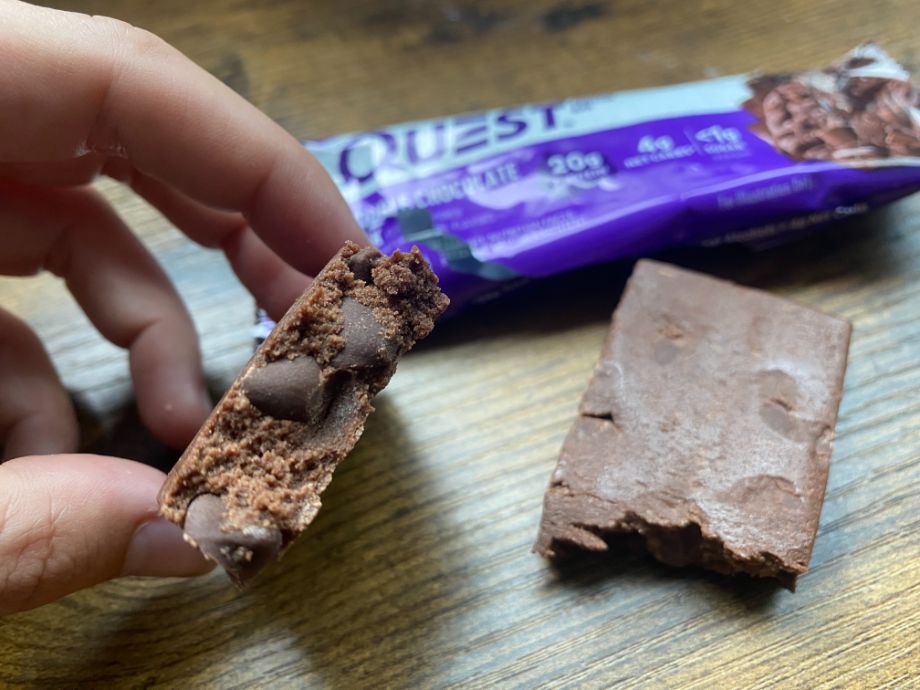
Amanda rated the texture a 3.5 out of 5, which she described as extremely dense and chewy. “I’m a fan of chewy, caramel-like textures, but this was almost too much for me. They definitely take a while to eat,” she noted.
It’s worth noting that if you tend to get bloated from erythritol, Quest Protein Bars may not be the best option. Per Amanda: “I can tolerate these fine in moderation, but I get bloating quickly when eating them every day.” They also contain sucralose, an artificial sweetener which can cause digestive upset in some people when consumed in excess.
One thing we really liked was Quest’s 90-day refund policy, which allows refunds for any reason when purchasing from their website. This means you can give these bars a shot without wasting your hard-earned money.
RELATED: Quest Protein Powder Review
| Price per serving | $1.96 |
| Protein per serving | 20 g |
| Calories per serving | 170 |
| Protein source | Milk Protein Isolate, Whey Protein Isolate |
Best Low-Calorie High-Protein Bar: Pure Protein Bar
Good for: Those looking to lose weight without sacrificing flavor
Best Low-Calorie
Pure Protein Bars
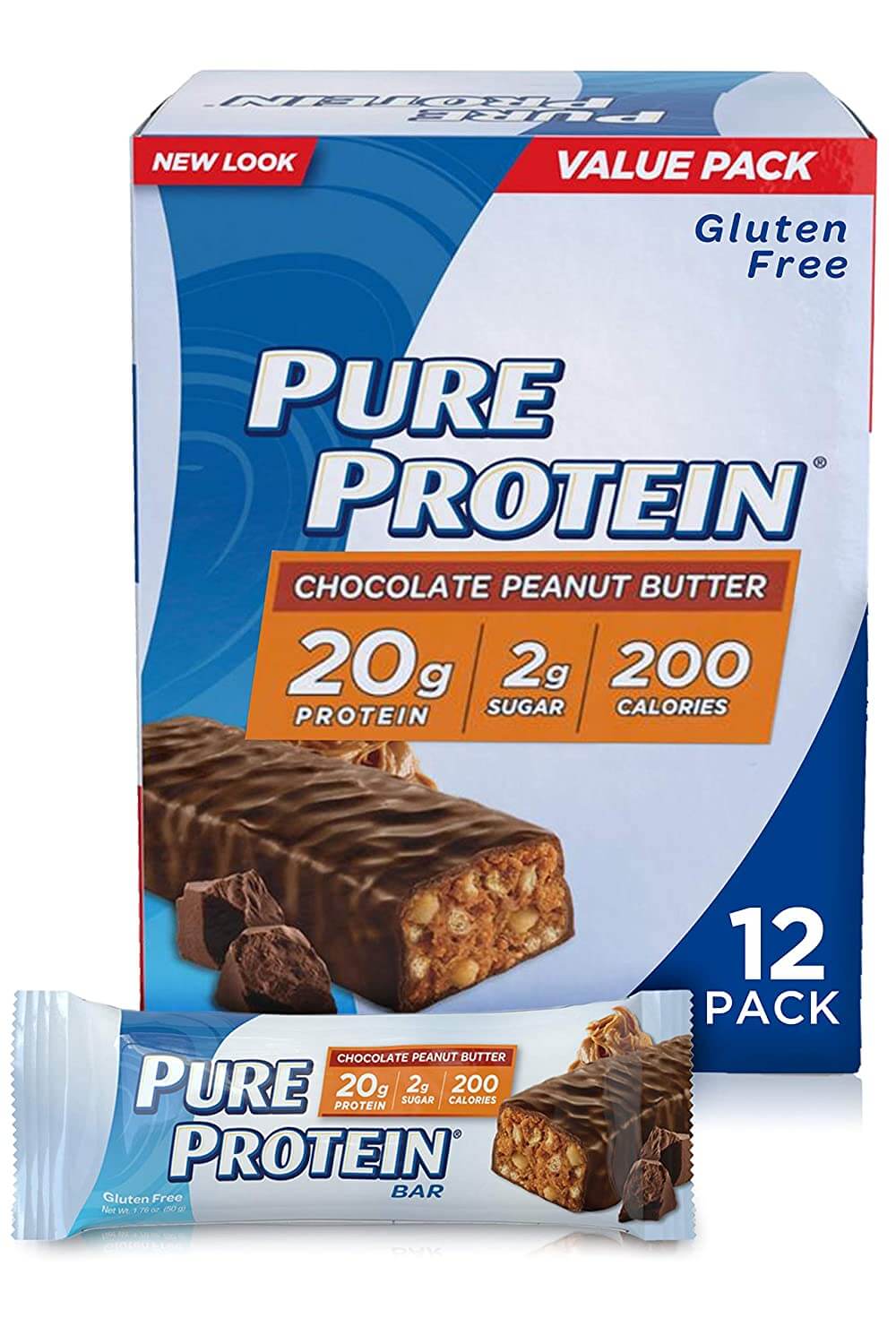
Product Highlights
- Low-sugar
- Gluten-free
- 20 g of protein per bar
- Great taste and flavor options
- Affordable
Pros & Cons
Pros
- Packed with protein that helps you feel full and reduce cravings
- Great price for overall quality of product
- Gives you fuel to keep an active lifestyle going
- Variety of flavor options to satisfy any sweet-tooth
- Tastes like candy
Cons
- The specific carb and calorie count will vary by flavor
- Uses artificial flavoring
- Includes artificial sweeteners
- Some customers felt these had a bit more aftertaste than other bars
Bottom Line
If you are trying to keep a diet that is balanced and are struggling to get enough protein in, this would be a great bar to add to your shopping cart, online or in person. Pair it with a piece of fruit, maybe a healthy carb, and a glass of water and you have a great meal on the go.
If you’re looking for an affordable bar with 20 grams of protein and an extensive variety of flavors for 200 calories or less, Pure Protein Bars are an excellent choice. In fact, our testers were so impressed with this bar that they chose it as the overall top pick in our round-up of the best low-calorie protein bars.
Kate Meier, NASM-CPT, USAW-L1, CF-L1, was really impressed by the Chocolate Peanut Butter flavor, which she gave a 4 out of 5 rating. “The peanut butter chocolate bars taste more like a real candy bar than any other bar I’ve tried. There’s a very slight hint of chalkiness, but it’s nowhere near what you get with other bars,” she noted.
The texture also got a 4 out of 5 rating from Kate. “It reminds me a lot of the ‘nougaty’ part of a Snickers or Milky Way candy bar.”

They could be a great option for people who get bored of eating protein bars every day but need to hit specific protein goals. As Kate said, “I usually end up losing the taste for most protein bars after eating them a few times, but I could eat the Pure Protein Bars for a long time without getting bored. They taste great and aren’t as dry as Quest Bars or RXBAR.”
They do contain an artificial sweetener, but we like how low they are in added sugars, which helps keep the calories low.
Overall, these are a great-tasting, highly-rated option for those who want to incorporate protein bars in their weight loss journey without suffering from flavor fatigue. One word of caution, however: they contain hydrolyzed collagen, so vegetarians will want to steer clear.
| Price per serving | $1.34 |
| Protein per serving | 20 g |
| Calories per serving | 180-200 (Depending on flavor) |
| Protein source | Protein Blend (Whey Protein Concentrate, Milk Protein Isolate, Whey Protein Isolate) |
Other High-Protein Bars We Researched
There are a lot of great high-protein bars out there, but we couldn’t include all of them. For context on how our top picks compare to the competition, we’ve listed a few others below:
No Cow Chocolate Chip Cookie Dough Protein Bars: These are a great option for plant-based eaters looking to get the most protein for the fewest possible calories. No Cow bars have 20-22 grams of protein per serving, but certain flavors are definitely better than others. Read more in our full No Cow Protein Bar Review.
Rise Whey Protein Bars: We love the simple formulation with only 3-5 ingredients per bar, plus the high protein content with no artificial sweeteners or sugar alcohols. However, they do tend to try out quickly and become chalky if you leave them in the pantry for too long.
Power Crunch Protein Bars: These dessert-like bars with minimal sugar are a great substitute for sweets, but with an artificial sweetener and only 12 grams of protein, they didn’t quite make the cut.
ALOHA Plant Based Protein Bars: They may be a great-tasting vegan option, but they’re a bit low in protein at only 14 grams. While we liked the fudgy consistency, most people looking for a protein bar will probably want something with fewer carbs. Read more in our full ALOHA Protein Bar Review.
Barebells Protein Bars: Available in plant-based or milk protein options, these bars are designed to mimic the flavors of your favorite candy bars with no added sugar. They taste just as good, but are relatively pricey and contain sucralose, an artificial sweetener.
How We Picked and Tested the Best High-Protein Bars
Our team of expert testers consists of certified personal trainers, USA Weightlifting coaches, certified nutrition coaches, and certified strength and conditioning coaches, to name a few. Each tester tried their assigned protein bar in place of their regular protein bar or post-workout shake.
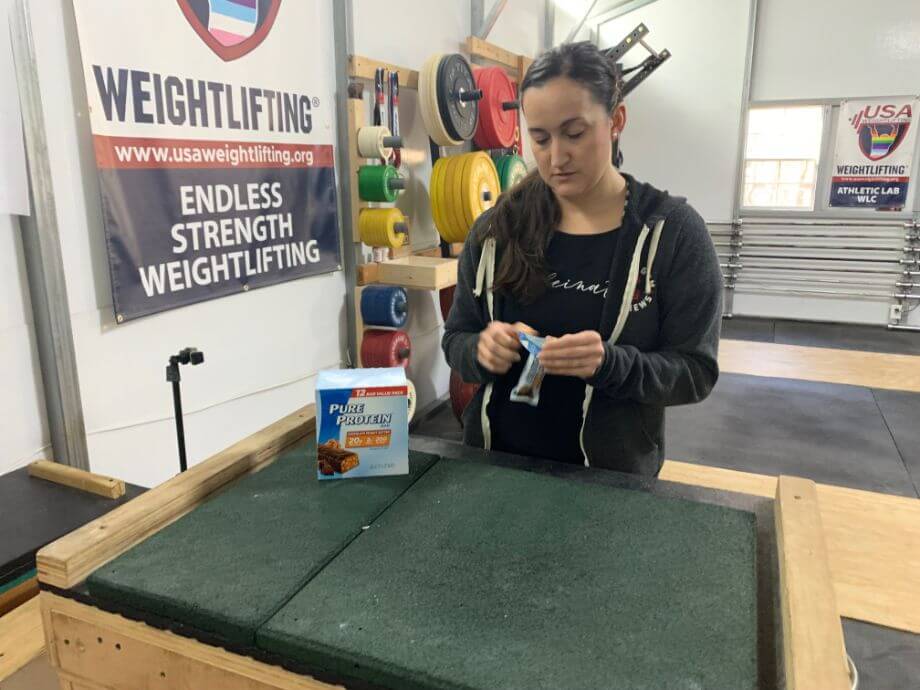
Our testers considered each of the following factors:
- Protein Dose: Since the whole point of eating a protein bar is to get a hefty dose of protein, the amount of protein in each bar is one of the most important considerations. We like to see upwards of 15-20 grams of protein per bar, but considered lower-protein options that scored particularly well in other areas.
- Taste: The best protein bars taste delicious and come in a variety of flavors without being sickeningly sweet or leaving a strange aftertaste in your mouth. We tried to choose bars that we actually enjoyed eating!
- Texture: Some bars have great macros, but are simply too dry, chalky, sticky, or chewy to eat on a daily basis. We looked for ones that were pleasantly fudgy, not too soft or chalky, or that had an enjoyable bite.
- Protein Quality: High-quality proteins give you more bang for your buck, especially when trying to build or maintain muscle. For animal proteins, we looked for whey protein isolates or milk protein. For plant-based options, we looked for complementary plant protein blends or soy protein.
- Side effects: Our testers made note of how each bar made them feel and noted symptoms like gas or bloating.
- Customer service: This includes policies related to returns, exchanges, and shipping, as well as how easy they are to contact and how quickly they respond to customer inquiries.
Benefits of High Protein Bars
Do you have to eat protein bars for good health? Not at all. It’s entirely possible for the vast majority of people to get enough protein from food alone. That said, protein bars can be helpful tools in certain situations or when trying to meet specific health and fitness goals.
Can Help Build Muscle
How much protein is needed to gain muscle? According to the International Society for Sports Nutrition1, 1.4 to 2 grams of protein per kilogram of body weight (in combination with resistance training) is ideal. This equates to 95 to 136 grams of protein for someone weighing 150 pounds. They also recommend spreading your protein intake evenly throughout the day.
With about 15 to 20 grams of protein, protein bars are a great tool for providing your body with the protein it needs to build lean mass. While most people can get enough protein from whole foods, bars are a convenient option.
Can Optimize Weight Loss
Eating in a calorie deficit is the only thing that is absolutely essential for losing weight, but there are additional strategies that can make it easier. Eating a higher-protein diet can boost weight loss by:
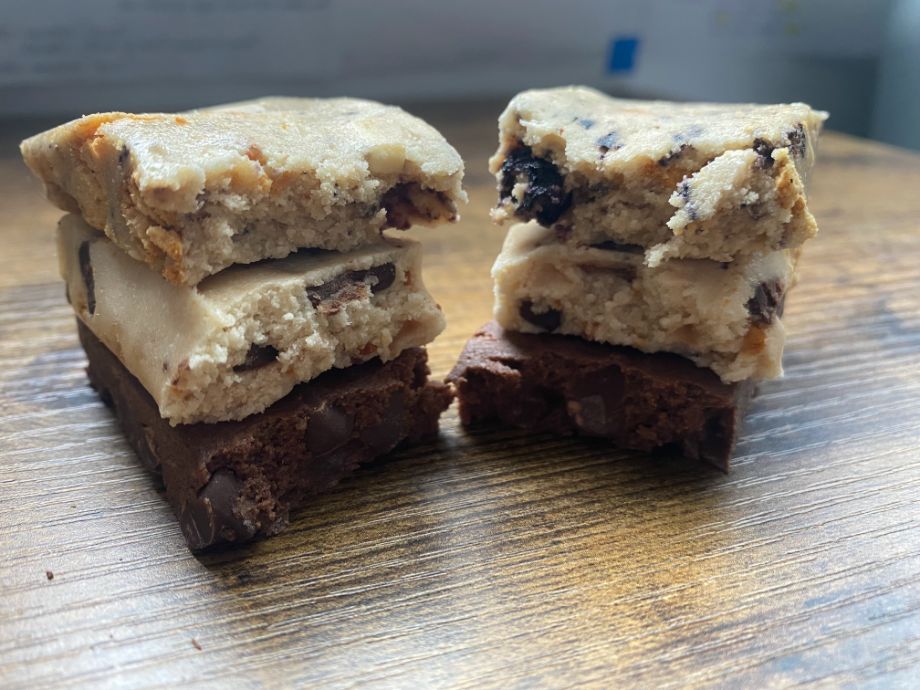
- Managing hunger: Protein helps you stay full and satisfied longer after a meal, potentially limiting the desire to snack on high-calorie foods
- Raising your metabolism: Protein takes more energy to digest and absorb than carbs or fat, so high-protein diets can help you burn more calories throughout the day. This is known as the thermic effect of food2.
- Preserving muscle tissue: During weight loss, the body burns both body fat and muscle for energy. Eating a high-protein diet and lifting weights can minimize muscle loss and encourage the body to burn a higher proportion of fat.
Travel-Friendly
Let’s be real—there are times when, despite our best efforts, busy schedules and time constraints can get in the way of meeting our nutrition goals.
Protein bars are a convenient, travel-friendly way to get some protein in even when rushing out the door. They’re perfect for throwing in a purse or gym bag. And unlike protein shakes, they don’t need to be refrigerated to taste their best.
Dosing and Interactions
Protein bars are safe to consume and don’t interact significantly with most supplements and medications. With the exception of people with health conditions that require them to restrict the amount of protein they eat, such as in certain stages of chronic kidney disease (CKD) or Phenylketonuria (PKU), protein bars are safe to consume for the majority of people.
Of course, it’s always a good idea to check with your physician or registered dietitian if you have questions.
Protein bars may contain allergens like milk, tree nuts, eggs, peanuts, soy, and wheat. Be sure to check product labels carefully if you have food allergies.
Third-Party Testing
Some dietary supplement brands choose to have their products independently tested by outside labs for the presence of heavy metals, stimulants, banned substances, and other contaminants.
Considering that the FDA doesn’t require supplements to be tested for these things, third-party testing provides consumers with the peace of mind that comes from knowing supplements are safe to consume.
Because protein bars are regulated according to the FDA requirements for food, however, they don’t typically undergo third-party testing.
Buying Guide: What to Look for in High Protein Bars
If you find yourself getting overwhelmed when trying to decipher protein bar labels, this Buying Guide will be your friend. Keep reading to learn what types of things to look for when choosing a high-protein bar.
Protein Content
If you’re trying to build muscle or preserve muscle while losing weight, you’ll benefit most from a high-protein bar with around 15 to 20 grams of protein.
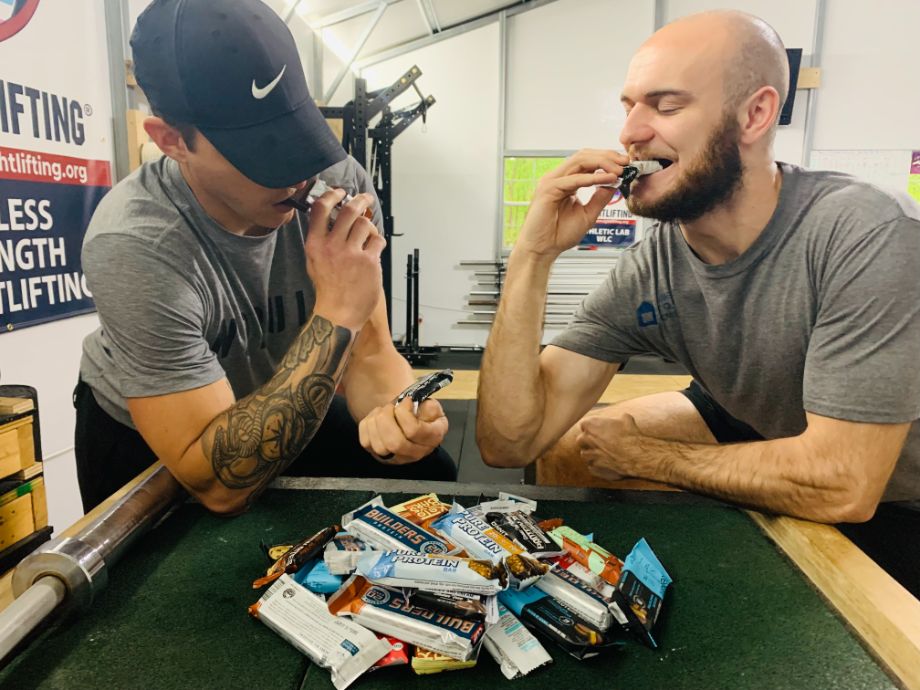
Be aware that some items are labeled as a “protein bar” yet contain less than 10 grams. This is totally fine if you’re just looking for a snack with some extra protein in it, but it’s less than ideal for people really trying to maximize their protein from a combination of bars and whole foods.
Dietary Needs and Preferences
Pay close attention to the ingredients in each protein bar if you follow a specific dietary pattern or have certain dietary needs. These are examples of important considerations:
- Lactose intolerance: Choose protein bars made from whey protein isolate, egg white protein, or plant-based proteins. Whey concentrate is higher in lactose. Watch out for added lactose or milk in the ingredients list, as well.
- Vegans: Choose bars made from plant-based proteins like soy, pea, rice, brown rice, wheat gluten, chia seed protein, or hemp protein. Scan the ingredients to make sure they don’t contain honey, eggs, collagen, lanolin-derived vitamin D3, or milk-based ingredients. Many brands are certified vegan, so look for these when possible.
- Vegetarians: Most protein bars are made from whey protein or plant proteins and are therefore vegetarian. Be sure to avoid bars with collagen, a protein derived from the bones, tendons, and ligaments of animals.
- Keto: Keto-friendly bars are often made with whey protein isolate, which is lower in carbs than whey protein concentrate or plant-based proteins. They’ll often include fats from coconut oil, MCT oil, butter, or nut butter. Watch out for bars with higher amounts of carbohydrates or added sugars.
- Paleo: Since the Paleo diet limits dairy and agricultural products, those following this diet will need to avoid bars made with whey protein, milk protein, grains, sugar, and legumes like soy or peas. Bars made from meat, collagen, eggs, nuts, and seeds are acceptable.
- Low-carb: Not surprisingly, you’ll want to choose a protein bar lower in carbs and added sugars if you’re on a low-carb diet. Check the nutrition facts label to see how many carbs each bar will contribute to your daily carb limit.
- Gluten-free: Some bars contain wheat gluten, wheat flour, or oats, the latter of which are often cross-contaminated with wheat during processing. Try to find certified gluten-free options to be safe.
Allergens
Depending on the protein source and other ingredients in each bar, protein bars can contain many allergens. Some you may come across include:
- Milk: From whey protein, milk protein, and some chocolate coatings
- Peanuts: From whole peanuts or powdered peanut butter/peanut flour
- Wheat: From products made with wheat gluten or wheat flour
- Eggs: Most often in bars made from egg white protein
- Tree nuts: These can include coconut, almonds or almond butter, cashews, and other tree nuts used for flavor and texture.
- Sesame: Sesame isn’t common in protein bars, but I’ve seen it used in nut-free bars.
Sweeteners
Protein bar brands use all sorts of different sweetening agents based on the type of consumer and price point they’re targeting.
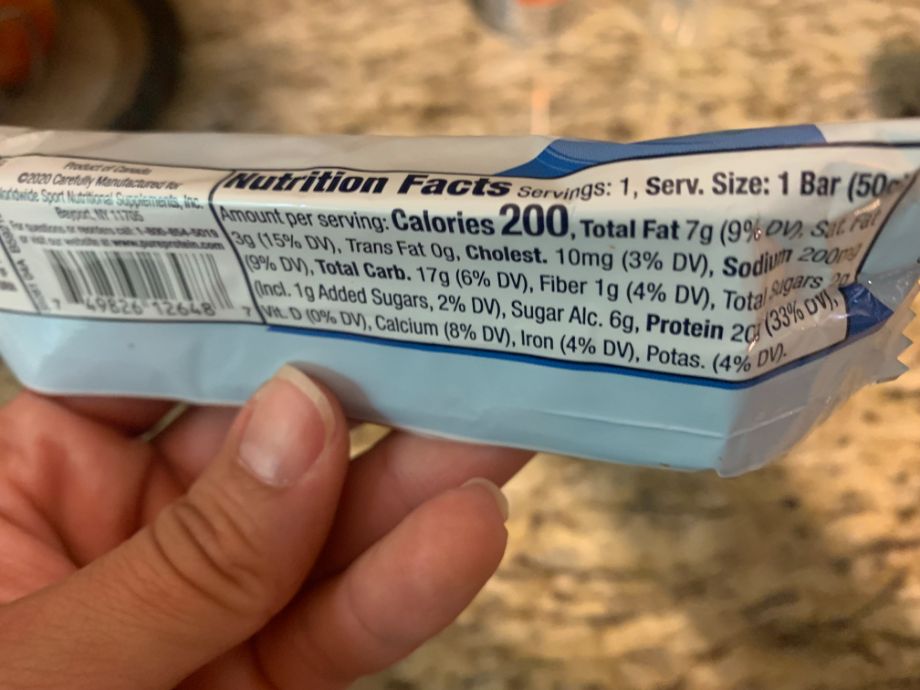
Many use sugar alcohols, non-caloric natural sweeteners, or artificial sweeteners in order to keep added sugars and calories low while maintaining a high proportion of protein to carbs. Examples of these include:
- Sugar alcohols (end in “-ol”): Erythritol, maltitol, sorbitol, xylitol, lactitol
- Non-caloric natural sweeteners: Stevia (stevia leaf, stevia extract, steviol glycosides, Rebaudioside A [Reb-A]), monk fruit
- Artificial sweeteners: Sucralose (Spenda), Aspartame, Saccharin, Acesulfame potassium (ACE-K)
Other sweeteners that do contribute added sugars and calories include:
- Cane sugar
- Honey
- Brown sugar
- Maple syrup
- Fructose
- Polydextrose
- Cane invert syrup
Sodium Content
One way that protein bar manufacturers improve the flavor of their products is by adding more salt. Small amounts of sodium are necessary for blood pressure regulation and proper muscle and nerve function, but consistently getting too much can elevate your blood pressure.
This is why it’s important to watch the sodium content of your favorite protein bars. Bars with moderate-to-high sodium may still fit within the recommended daily limit of 2,300 milligrams, but you may need to watch the sodium content of the rest of your diet throughout the day.
For context, bars classified as “low-sodium” contain 140 milligrams of sodium or less.
Saturated Fat
Since most high-protein bars are much higher in protein than carbs or fat, they’re usually pretty low in saturated fat. The exception is bars made with high amounts of:
- Coconut oil
- MCT oil
- Ghee
- Butter
For example, the BSN Protein Crisp Bar contains 20% of the Daily Value for saturated fat, while keto-friendly MariGold Protein Bars contain a whopping 36%. That’s over a third of the total recommended saturated fat limit for the whole day, so it’s important to watch how much saturated fat you’re also getting from meals.
Food Additives
Depending on the degree of processing, some protein bars contain a lot of food additives. These are all safe to consume, but it’s always good to be educated on unfamiliar ingredients. Some food additives you may come across include:
- Sunflower/soy lecithin: Emulsifiers that improve texture
- Natural flavors: Flavorings that can come from plant or animal sources (not the same as artificial flavors)
- Glycerin: Helps retain moisture and prevents sugar crystallization
- Citric acid: Extends shelf-life
- Calcium carbonate: Regulates pH and serves as a preservative
- Gums: Xanthan, guar, and acacia gums help stabilize and thicken foods
Other Ingredients
Lastly, protein bars often contain additional ingredients like:
- Vegetable fibers
- Canola, sunflower, soy, or vegetable oil
- Vegetable starches
These are usually used in fruit, yogurt, or chocolate layers or texturized components like rice crisps in order to provide more structure and bulk to the bar.
Best High-Protein Bars: FAQs
Which bar has the highest protein?
The most protein you’ll typically find in a protein bar is 20 to 21 grams. Beyond this, protein bars start to become unpalatable. After testing dozens of protein bars, we’ve found that Legion Protein Bars, Julian Bakery Protein, PowerBar Protein Plus, BSN Protein Crisp, Quest Protein, and Pure Protein are the best high-protein bars with at least 20 grams of protein.
Which are the healthiest protein bars?
It’s difficult to say definitively which protein bars are healthiest for each person, but the most nutritious ones tend to be low in added sugars, sodium, and saturated fat. You can check out our top picks for a variety of nutrition and health needs below:
–Best Low Sugar Protein Bars
–Best Low Calorie Protein Bars
–Best Low Carb Protein Bars
Some people prefer protein bars made from whole food ingredients instead of highly processed protein powders, or ones that include other healthy ingredients like flaxseed or almond butter. While these tend to be a bit lower in protein, a few options include Rise Protein Bars, GoMacro Bars, and RXBAR.
Are high protein bars good for you?
Protein bars are a helpful way to meet increased protein needs and support muscle-building or weight loss efforts. That said, some can be high in added sugars, saturated fat, sodium, or sweeteners that may cause digestive distress in some people.
Is it OK to eat a protein bar everyday?
It’s OK to eat protein bars every day, but you don’t want to overdo it. It’s best to consume no more than one to two protein bars a day as a supplement to a balanced diet that includes whole, minimally processed high protein foods.
These statements have not been evaluated by the Food and Drug Administration. This product is not intended to diagnose, treat, cure, or prevent any diseases.
References
- Jäger, R., Kerksick, C. M., Campbell, B. I., Cribb, P. J., Wells, S. D., Skwiat, T. M., Purpura, M., Ziegenfuss, T. N., Ferrando, A. A., Arent, S. M., Smith-Ryan, A. E., Stout, J. R., Arciero, P. J., Ormsbee, M. J., Taylor, L. W., Wilborn, C. D., Kalman, D. S., Kreider, R. B., Willoughby, D. S., Hoffman, J. R., … Antonio, J. (2017). International Society of Sports Nutrition Position Stand: protein and exercise. Journal of the International Society of Sports Nutrition, 14, 20. https://doi.org/10.1186/s12970-017-0177-8
- Calcagno, M., Kahleova, H., Alwarith, J., Burgess, N. N., Flores, R. A., Busta, M. L., & Barnard, N. D. (2019). The Thermic Effect of Food: A Review. Journal of the American College of Nutrition, 38(6), 547–551. https://doi.org/10.1080/07315724.2018.1552544






